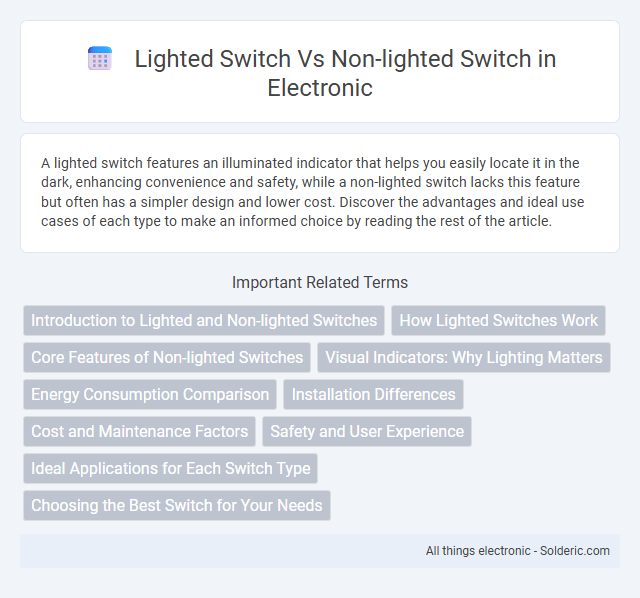A lighted switch features an illuminated indicator that helps you easily locate it in the dark, enhancing convenience and safety, while a non-lighted switch lacks this feature but often has a simpler design and lower cost. Discover the advantages and ideal use cases of each type to make an informed choice by reading the rest of the article.
Comparison Table
| Feature | Lighted Switch | Non-Lighted Switch |
|---|---|---|
| Indicator Light | Yes, built-in LED or neon light shows switch status | No indicator light |
| Visibility in Dark | Easy to locate in low light | Difficult to find without external light |
| Power Consumption | Consumes minimal additional power due to light | No additional power consumption |
| Installation Complexity | Slightly complex; requires wiring for light | Simple wiring |
| Cost | Higher cost due to internal lighting components | Lower cost, standard switch mechanism |
| Use Case | Ideal for locating switches in dark or for status indication | Suitable for standard switching needs without indication |
Introduction to Lighted and Non-lighted Switches
Lighted switches feature built-in indicators, usually LED or neon lights, that illuminate when the switch is in the "on" position, providing visual confirmation of the circuit status. Non-lighted switches lack this illumination, functioning solely as a basic on/off control without any visual indicator. Understanding the differences between these switches is crucial for applications requiring quick status identification or aesthetic preferences in electrical wiring.
How Lighted Switches Work
Lighted switches contain a small built-in light, often an LED or neon bulb, that illuminates when the switch is in the OFF position or when power is present, making it easier to locate in the dark. This internal lighting functions through a small current passing through the switch without activating the connected load, enhancing usability and safety in low-light environments. Your choice between lighted and non-lighted switches depends on whether visual indication or energy efficiency is prioritized in your electrical setup.
Core Features of Non-lighted Switches
Non-lighted switches feature a simple design with no built-in illumination, providing basic on/off functionality without visual indicators. They are cost-effective and ideal for applications where status confirmation is unnecessary. Your choice depends on whether you need a switch that signals operation or prefers minimalism and straightforward use.
Visual Indicators: Why Lighting Matters
Lighted switches provide immediate visual indicators that signal the switch's status, enhancing safety and convenience in various lighting conditions. Non-lighted switches lack these visual cues, making it harder to locate or determine if a device is on, especially in dark environments. Your choice between lighted and non-lighted switches can significantly impact ease of use and energy efficiency.
Energy Consumption Comparison
Lighted switches consume a small amount of energy continuously to power the indicator light, typically around 0.1 to 0.5 watts, which can add up over time in a household with multiple switches. Non-lighted switches, on the other hand, do not draw any power when off, making them more energy-efficient overall. Your choice between the two should consider the minimal energy trade-off versus the convenience of locating switches in the dark.
Installation Differences
Lighted switches require a neutral wire for installation to power the internal indicator light, while non-lighted switches do not need this additional wiring. Installing lighted switches involves connecting the neutral wire along with the line and load wires, which may not be present in older homes designed for non-lighted switches. Careful identification of wiring types and circuit compatibility is crucial to ensure proper function and safety during installation of lighted versus non-lighted switches.
Cost and Maintenance Factors
Lighted switches generally cost more upfront due to built-in LED indicators and require occasional bulb or LED replacement, increasing maintenance efforts compared to non-lighted switches. Non-lighted switches have lower initial costs and minimal maintenance since they lack additional electronic components. Budget-conscious projects often favor non-lighted switches for cost efficiency, while lighted switches offer convenience despite higher expenses.
Safety and User Experience
Lighted switches enhance safety by providing a clear visual indicator of the switch's status in low-light conditions, reducing the risk of accidental activation or deactivation. Non-lighted switches may cause confusion in dark environments, increasing the chance of errors during operation. The illuminated design of lighted switches improves user experience by enabling easy identification and intuitive use, especially in critical or frequently accessed areas.
Ideal Applications for Each Switch Type
Lighted switches are ideal for applications requiring visual status indicators, such as in home automation systems, control panels, and appliances where users benefit from knowing whether a device is powered on or off. Non-lighted switches suit environments where simplicity and cost-effectiveness are priorities, commonly used in residential lighting and basic electrical circuits without the need for illumination feedback. Selecting the appropriate switch type depends on the necessity for operational visibility and user interface clarity in the specific application.
Choosing the Best Switch for Your Needs
Lighted switches provide visual confirmation by illuminating when activated, making them ideal for areas with low visibility or for quickly identifying switch status. Non-lighted switches offer a simpler, cost-effective solution without illumination, suitable for well-lit environments where such indicators are unnecessary. Choosing the best switch for your needs depends on factors like lighting conditions, ease of use, and the importance of visual feedback in your space.
Lighted switch vs Non-lighted switch Infographic

 solderic.com
solderic.com